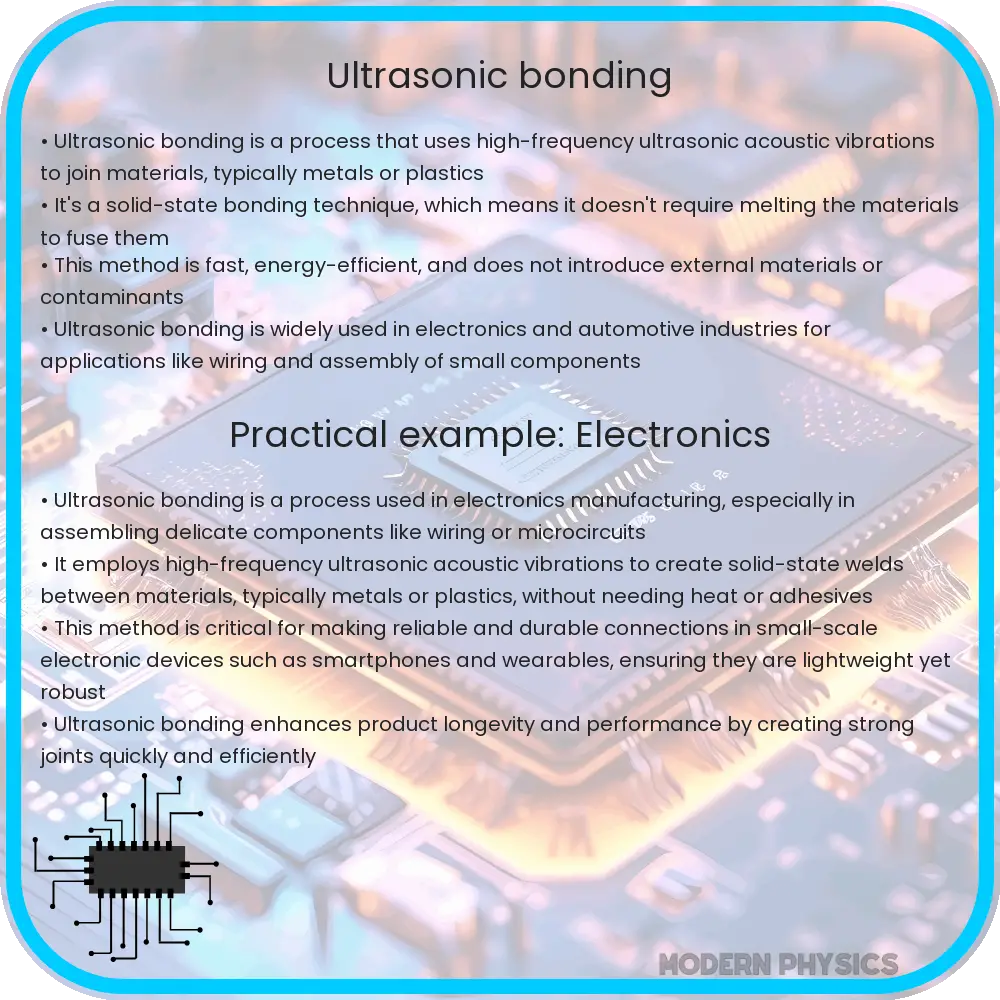Ultrasonic bonding is a manufacturing technique that joins materials using high-frequency acoustic vibrations, ideal for metals and plastics in various industries.

Understanding Ultrasonic Bonding: A Modern Marvel in Manufacturing
Ultrasonic bonding is a sophisticated technique used extensively in manufacturing for joining materials, primarily metals and plastics, without the need for adhesives, screws, or other traditional fastening methods. This method leverages high-frequency ultrasonic acoustic vibrations to create a solid-state weld between materials under pressure. It’s favored for its speed, energy efficiency, and the strong bond it forms, making it indispensable in various industrial applications, including electronics, automotive, and medical device manufacturing.
How Ultrasonic Bonding Works
In ultrasonic bonding, mechanical vibrations are applied to materials being joined. The process typically involves an ultrasonic tool, often referred to as a “horn” or “sonotrode”, that delivers vibrations to the materials at frequencies ranging from 20 kHz to 40 kHz. These vibrations, when applied under pressure, generate frictional heat at the interface of the materials, causing local melting of the materials (if thermoplastic) or plastic deformation (if metal), without melting the entire substrates. This results in a clean, strong weld in just seconds.
Components and Mechanism
- Transducer: Converts electrical energy into mechanical vibrations.
- Booster: Modifies the amplitude of the vibrations from the transducer.
- Horn: Directly contacts the workpieces, applying the ultrasonic energy to the joint area.
- Anvil: Supports the workpiece against the vibrations from the horn.
The actual process starts when the ultrasonic stack (transducer, booster, and horn) is lowered onto the materials clamped on an anvil. The transducer generates vibrations, which are intensified by the booster and transmitted through the horn. As the horn delivers these vibrations into the materials, the molecular friction heats up and softens the junction point. Under applied pressure, the materials are forged together, forming a cohesive bond on cooling and solidifying.
Advantages of Ultrasonic Bonding
- Speed: Bonds are typically formed in less than a second.
- Energy Efficiency: Consumes very little energy compared to other welding techniques due to the localized heating.
- Versatility: Can be used on a variety of materials including dissimilar ones.
- Environmentally Friendly: No need for solvents, adhesives, or other consumables.
- Automation: Easily automated, making it ideal for high-volume production lines.
The ability to join materials such as copper, aluminum, and different types of plastics without damaging sensitive components makes ultrasonic bonding a particularly valuable technique in industries where precision and reliability are critical.
Applications of Ultrasonic Bonding
Ultrasonic bonding’s unique capabilities make it suitable for a wide range of applications. In the electronics industry, it is used for wire bonding in microelectronics and semiconductor chip packaging. The automotive sector utilizes this technology for assembling large plastic parts and electrical components, whereas in medical manufacturing, it helps in the creation of disposable medical devices such as catheters and filters that require sterile bonds.
The method’s adaptability and efficiency also make it favorable for packaging, where it is used to seal packaging materials without the risk of contaminating the product. This is particularly advantageous in food packaging and pharmaceuticals, where maintaining the integrity and sterility of the packaging is essential.
Future Prospects and Challenges
As technology advances, the potential for ultrasonic bonding continues to expand. Future developments are expected to focus on refining the process for even greater precision and control, particularly in the realms of nano and microfabrications. However, challenges such as controlling the interfacial temperature and ensuring uniform material properties during the bonding process remain. Overcoming these challenges will be crucial for further advancements and broader application scopes of this technology.
Conclusion
Ultrasonic bonding stands out as a remarkable technology in modern manufacturing due to its efficiency, versatility, and environmental benefits. By transforming how materials are fused, especially in fields requiring high precision and cleanliness, it responds adeptly to the evolving demands of various industries. As researchers and engineers continue to address its challenges and expand its capabilities, ultrasonic bonding is poised to play an even more integral role in future manufacturing processes. Adopting this technology can lead to significant improvements in product quality and production efficiency, making it a cornerstone of innovative manufacturing strategies.
The journey from understanding the basic mechanisms of ultrasonic bonding to appreciating its extensive industrial applications and potential future enhancements illustrates its importance. For industries looking to enhance operational efficiency while maintaining high quality and environmental stewardship, ultrasonic bonding offers a promising solution. Thus, embracing this technology not only optimizes manufacturing processes but also contributes to a more sustainable industrial future.
